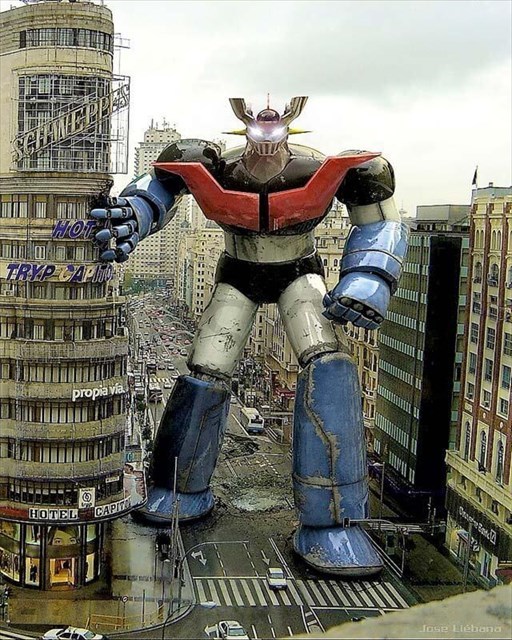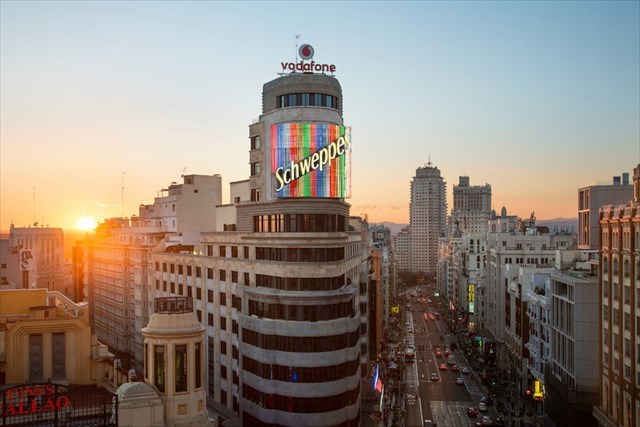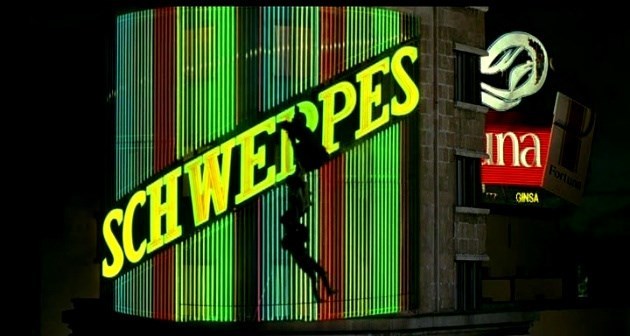El luminoso del Edificio Carrión es uno de aquellos símbolos “pop” más arraigados en los habitantes en la ciudad pero que para el visitante le puede pasar por alto. Para muchos, lleva ahí toda la vida (en 2022 cumplió 50 años) siendo testigo y protagonista a partes iguales del día a día de una ciudad que perdería un poquito de su esencia si en algún momento desapareciera del lugar privilegiado que ocupa en la Plaza del Callao.

El letrero mide 10,65 x 9,36 metros, las letras pesan 100 kilos y el conjunto del letrero 600. Lo integran 104 neones. Está situado a 37 metros de altura sobre la fachada del esbelto torreón que corona el edificio Carrión. Tras el letrero encontramos dos habitaciones suites del Hotel albergado en el edificio. No fue el primer cartel del edificio, antes de que se instalara este había un anuncio de una marca de tabaco. Tampoco es el primer cartel luminoso de Madrid. Existía incluso uno anterior del mismo anunciante que estaba situado muy cerca, concretamente en la calle San Bernardo y que representaba una botella en efervescencia pero desafortunadamente ya no existe. El luminoso más antiguo que aún se mantiene en funcionamiento es el de una marca de la manzanilla, en la Puerta del Sol, que fue colocado en 1935 y que ha soportado incluso los bombardeos de la Guerra Civil y está declarado Patrimonio de Madrid.
Unos 32 años después de su colocación, en 2004, el anuncio fue retirado durante 10 semanas, se cambiaron las letras mayúsculas de la marca por minúsculas y se restauró por completo el luminoso para renovar la instalación y eliminar los restos de contaminación que lo cubrían. Además, se realizan revisiones anuales de la estructura y sus componentes sin retirar el cartel. Las incidencias habituales son la renovación de los tubos de neón y la sustitución de transformadores.
Aunque no fue el primer cartel ni el más creativo, es cierto que es el más emblemático de los carteles luminosos y el más reconocible. Su colocación en los 70 coincide justo con el nacimiento de la cultura urbana en Madrid y han hecho que a posteriori se haya convertido en un icono. Y es que su aparición en escenas e imágenes de películas, series, pinturas o fotografías de Madrid le han convertido en un elemento tan reconocible como indispensable para la ciudad y sus habitantes. La aparición más popular seguramente haya sido en 1995, en una de las escenas más míticas del cine español, en la película El Día de la Bestia, de Álex de la Iglesia, cuando los protagonistas de la película trepan por sus letras. ¿Una curiosidad? no se descolgaron del original, sino de una réplica exacta reproducida para la grabación de la escena en estudio por motivos de seguridad.
En el año 2009 se aprobó una ordenanza que regulaba la publicidad exterior en la ciudad [prohibía los rótulos luminosos en el centro de la urbe]. Como resultado de años de poco control y regulación del sector, existían carteles y luminosos que contaminaban luminicamente y paisajísticamente la capital. Sin embargo, desde el principio se creyó que varios de ellos debían ser considerados como bienes culturales y por tanto ser indultados. De hecho, fue en 2010 cuando el Ayuntamiento otorgó al luminoso la categoría de Rótulo Histórico tras la petición de indulto por parte de la compañía.
El neón funciona desde las 05H00 hasta las 08H00 y desde las 17H00 hasta las 02H00 durante los meses de invierno (entre el 1 de noviembre y el 31 de marzo). Durante el verano (del 1 de abril al 31 de octubre), desde las 06H00 hasta las 08H00 y entre las 21H00 y las 02H00.
Tiene un ciclo en el que empieza encendiéndose poco a poco la marca de color azul y después de color amarillo. Cuando acaba esta parte, se ilumina el neón de colores de derecha a izquierda y se apaga de izquierda a derecha dos veces cada paso. Más tarde, se enciende el neón de fuera hacia dentro y se apaga de dentro hacia fuera tres veces cada uno. Después, color a color del neón, cada uno va encendiéndose y apagándose (uno sí, otro no) cinco veces. El ciclo acaba con el encendido de todo el neón y la marca de color amarillo parpadeando tres veces.
Registro del Caché.Las coordenadas te indican una farola. Si te fijas bien, a sus pies podrás ver un código de seis caracteres. Este es el código es un Travel Bug que debes registrar para validar el caché. Además, en el Log tienes hay que postear una foto tuya (o tu GPS o tu alterego o tu nombre de usuario escrito en un papel) en la que se vea el luminoso. Si no sabes como registrar el Travel Bug, puedes enviarme el código como respuesta.

Edificio Carrion's Neon Lights
This luminous is one of those pop symbols more deeply rooted in the Madrilians but for the visitor it can be overlooked. For many, it has been there all the life (50 years in 2022) being witness and protagonist to equal parts of the day to day of a city that would lose a little of its essence if at some moment it disappeared of the privileged place that occupies in the Plaza del Callao.
The total sign measures 10.65 x 9.36 meters, the letters weigh 100 kilos and the sign 600 as a whole. It is made up of 104 neons. It is located 37 meters above the facade of the slender tower that crowns the Carrión building. After the sign we find two suites rooms of the Hotel housed in the building. It was not the first sign of the building, before it was installed there was an advertisement for a tobacco brand. Nor is it the first bright sign of Madrid. There was even an earlier one from the same advertiser that was located very close, specifically in the street San Bernardo and representing a bottle in effervescence but unfortunately no longer exists. The oldest luminous still in operation is that of the "Tío Pepe" sweet wine in the Puerta del Sol, which was placed in 1935 and has endured even the bombing of the Civil War and is declared a Heritage of Madrid.
Some 32 years after its placement, in 2004, the neon advertising was removed for 10 weeks, upper case letters of the trademark were changed to lower case letters and the luminous was completely restored to renew the installation and eliminate the remains of contamination that caused it. they covered. In addition, annual reviews of the structure and its components are carried out without removing the poster. The usual incidents are the renewal of neon tubes and the replacement of transformers.

Although it was not the first poster or the most creative, it is true that it is the most emblematic of the luminous signs and the most recognizable. Its placement in the 70s coincides with the birth of urban culture in Madrid and has made it a posteriori has become an icon. And it is that his appearance in scenes and images of movies, series, paintings or photographs of Madrid have made him an element so recognizable as indispensable for the city and its inhabitants. The most popular appearance was probably in 1995, in one of the most mythical scenes of Spanish cinema, in the film "El Día de la Bestia", by Álex de la Iglesia, when the protagonists of the film climb for their lyrics. A curiosity? they did not take off from the original, but from an exact replica reproduced for the recording of the scene in study for reasons of security.
In 2009, an ordinance was passed regulating outdoor advertising in the city [it prohibited the illuminated signs in the center of the city]. As a result of years of little control and regulation of the sector, there were signs and lights that polluted light and landscaping the capital. However, from the beginning it was believed that several of them should be considered as cultural property and therefore be pardoned. In fact, it was in 2010 when the City Council gave the luminous the category of Historical Label after the request of pardon by the company.
The neon operates from 05:00 to 08:00 and from 5:00 to 2:00 during the winter months (between November 1 and March 31). During the summer (from April 1 to October 31), from 06:00 to 08:00 and between 21:00 and 02:00.
It has a cycle in which the brand starts to light up little by little, blue and then yellow. When this part ends, the neon of colors lights up from right to left and goes off from left to right twice each step. Later on, the neon is turned on from the outside in and goes out from the inside out three times each. Then, color to neon, each one goes on and off (one yes, another no) five times. The cycle ends with the ignition of all the neon and the yellow brand blinking three times.
Cache registration.
The coordinates point you to a lamppost. If you look closely, at its foot you will see a six-character code. This code is a Travel Bug and you must register it to validate the cache. In addition, in the Log you have to post a picture of yourself (or your GPS or your alterego or your user name written on a piece of paper) in which you can see the light. If you don't know how to register the Travel Bug, you can send me the code as a reply.
Virtual Rewards 2.0 - 2019/2020
This Virtual Cache is part of a limited release of Virtuals created between June 4, 2019 and June 4, 2020. Only 4,000 cache owners were given the opportunity to hide a Virtual Cache. Learn more about Virtual Rewards 2.0 on the Geocaching Blog.